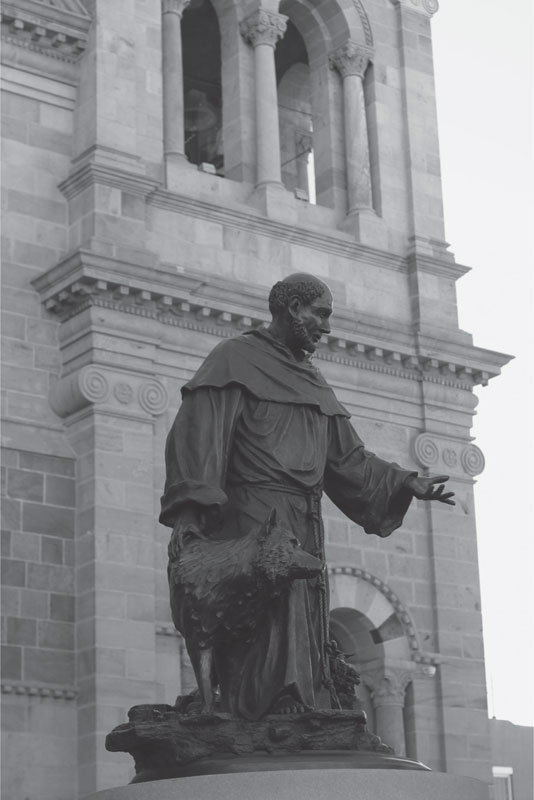
St. Francis Cathedral was built at the request of Bishop Jean-Baptiste Lamy, who is immortalized in statue form in front of his beloved church. Courtesy of the author.
5
SANTA FE
HISTORIC SANTA FE
Often referred to as the “City Different,” Santa Fe lives up to its name. As the oldest capital city in the United States, founded in 1610 by Spanish colonists, Santa Fe has seen many changes and upheavals. Santa Fe (“holy faith”) began its existence with a grand name. La Villa Real de la Santa Fe de San Francisco de Asís is its official name (“The Royal City of the Holy Faith of Saint Francis of Assisi”). St. Francis Cathedral is a tribute to this gentle saint as well.
As the fourth-largest city in New Mexico, Santa Fe has always been an economic hub. The early Tewa people built their villages several hundred years before the insurgence of the Spaniards in this area. They called their settlement Ogha Po’oge, which means “white shell water place.” They were followed by the Tanoans and Puebloan people, who established pueblo structures in the area close to the Santa Fe River.
Most of northern New Mexico was involved in the Revolt of 1680, also known as Popè’s Rebellion, when the native people revolted against the Spaniard inhabitants. The result was the deaths of more than four hundred Spanish men, women and children, as well as the complete exile of two thousand colonists, who were able to escape from the lands the Spaniards had taken from the Puebloan people. An attempt by the native people to wipe out all existence of the Spanish culture was then complete. During this cleanse, many manuscripts, churches and works of art were destroyed. This happened in all the surrounding towns and villages, including Taos and Albuquerque.

St. Francis Cathedral was built at the request of Bishop Jean-Baptiste Lamy, who is immortalized in statue form in front of his beloved church. Courtesy of the author.
The revolt was an ingenious plan devised by Popè, a medicine man from San Juan who demanded absolute secrecy from his people. He developed a message system involving a knotted rope that was taken by messenger to the pueblos without the knowledge of their oppressors. Each knot represented a day and time, so each of the pueblos were aware of when to commence its attacks.
The main reason for the revolt stemmed from the Spaniards’ demand that the native people abandon all their religious beliefs and convert to Catholicism. The penalty for not complying was imprisonment and death. In 1675, forty-seven medicine men were arrested from the pueblos and tried for witchcraft. Four of these men were found guilty and hanged. This sparked even more hatred for the Spaniards among the Pueblo people and was the impetus for initiation of the plan.
Once the revolt was over, the native people returned to their everyday lives and did not continue the fight. Slowly, by 1692, the Spaniards had returned and reestablished their colonies, but because the ancient Pueblo people had proven their point and gained the respect of the Spanish, they were able to maintain their traditions and rituals without punishment.
The city as we know it today was created by New Mexico’s second Spanish governor, Don Pedro de Peralta, at the foot of the magnificent Sangre de Cristo (“blood of Christ”) Mountain range. Santa Fe would remain under Spanish rule until 1824, when it became the capital of the Mexican territory. The city would then be claimed by the Republic of Texas once it seceded from Mexico in 1836. In 1846, Brigadier General Stephen W. Kearny and 1,700 of his soldiers conquered Santa Fe to obtain it and the entire New Mexico Territory for the United States. This status was made official by the signing of the Treaty of Guadalupe Hidalgo in 1848.
SANTA FE TODAY
Modern-day Santa Fe has become a mecca for celebrities and those who seek a break from the surrounding world. One whiff of the piñon-scented air on a cool fall evening will grab your soul. Whether you are strolling along the famous art avenue, Canyon Road or experiencing the Santa Fe Plaza with the Native American vendors selling their beautiful handmade items, you will surely see something new and exciting at every glance.
Santa Fe is truly a visually beautiful city. The vivid southwestern colors, foliage, brightly painted doors, gorgeous mountain backdrop and adobe architecture will lure you into the quaint shops and restaurants and transport you back in time. Many of the shops surrounding the Santa Fe Plaza are original structures of the 1600s and later, with only a small number of upgrades. According to city ordinance, all structures built in and around the historic district must adhere to the Pueblo or Territorial styles of architecture.
A unique venue has popped up in recent years and is causing quite a stir. The Meow Wolf is a place where all the hip people hang out. Musical acts from all over come to the setting to be seen and heard. It is the epitome of the “City Different” vibe. Called the “House of Eternal Return,” Meow Wolf is a Victorian house built inside a former bowling alley. Owned by local author George R.R. Martin, of Game of Thornes fame, the Meow Wolf is accessed through fireplaces, refrigerators and other one-of-a-kind portals.
For ski buffs, Ski Santa Fe provides a challenging experience at the top of Mount Baldy, which rises 10,350 feet above the town. Santa Fe sees approximately 225 inches of snow per year, which feeds the eighty-three trails in the 660-acre basin. Billed as “one of the country’s most diverse and unique ski destinations” by the New Mexico Ski Hall of Fame, Ski Santa Fe was started by famed thrill-seeker and New Mexico Ski Hall of Fame inductee Ben Abruzzo and his business partner, Bob Nordhaus, in 1984. The Abruzzo family still runs the resort today.
The Santa Fe Plaza and surrounding blocks provide visitors with access to art galleries, high-end jewelry shops, Christmas shops, international shops, a variety of clothing and kitchenware stores, museums, a library, nostalgic stores, as well as a multitude of restaurants and bistros. One of the largest draws to the Santa Fe Plaza is the handmade native jewelry for sale under the veranda of the Palace of the Governors. All of the items sold under the Portal (front porch) at the Governors Palace must adhere to strict rules put in place in 1936 by the Native American Vendors Program, which was developed by the Museum of New Mexico. The rules of the program state that all of the items presented by vendors for sale under this popular portal must be handcrafted by native people and authentic in order to be sold to the more than 2.4 million visitors to the Santa Fe Plaza location each year.
LA POSADA DE SANTA FE RESORT AND SPA
Billed as one of the most renowned resorts in Santa Fe, La Posada de Santa Fe is a distinctly beautiful hotel offering many high-end amenities. Sitting on six acres of prime Santa Fe real estate, La Posada has the privilege of being the only resort located in downtown Santa Fe.
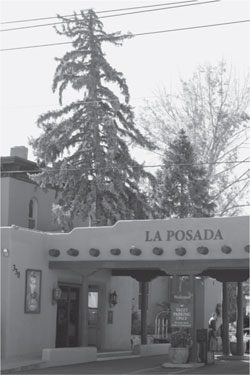
Nestled just two blocks east of the Santa Fe Plaza is La Posada de Santa Fe Resort. The name means “inn” or “resting place.” Courtesy of the author.
The original structure, situated on Palace Avenue, was a three-story Second Empire–style mansion and carriage house built in 1882 by wealthy Santa Fe merchant Abraham Staab and his wife, Julia. This home played host to many of Santa Fe’s elite in elaborate events, which Julia would extend to her family and friends. This home was appointed with many European fineries not easily found in the wilds of the New Mexico Territory.
The Staab House is now the bar of La Posada de Santa Fe Resort and Spa; in the 1930s, owners R.H. and Eulalia Nason built a series of Pueblo-style casitas around the existing Staab Mansion and carriage house. The Nasons were to name their business La Posada, which means “inn” or “place of rest.” They opened a summer arts school, which became a significant part of the Santa Fe art culture and attracted many well-known artists.
Additional construction of lodging areas and massive renovations in the 1990s produced the magnificent La Posada de Santa Fe Resort and Spa we have today. Today, the resort celebrates the life of the “lady of the house,” Julia Staab, in the form of Julia’s Spirited Restaurant and Bar, named in her honor.
GHOSTS
Socialite Julia Staab loved her home so much that, it is said, she never left. But that was not always the case. Her spirit has been described as a gentle ghost.
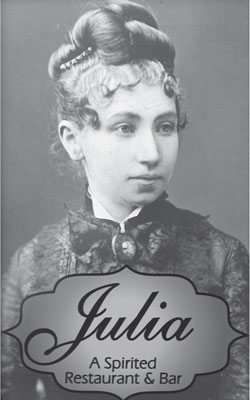
Julia Staab is said to have loved her home so much, she is still there, seen walking down the original staircase of her beautiful house. Courtesy of the author.
As a young woman, Julia Schuster grew up in Lügde, Germany, in the same town as her future husband, Abraham Staab. Abraham came to America at age fifteen to join his brother Zadoc to work for their cousins the Spiegelbergs in Santa Fe. The brothers opened a dry goods store in 1859 on the Santa Fe Plaza. By 1865, Abraham had made enough money to return to Germany and marry Julia on Christmas Day. When the couple returned to Santa Fe, Julia was shocked at the lack of amenities in their humble home on Burro Alley.
The couple would have seven children and, by all accounts, was a happy couple, until the death of their eighth child, a daughter. Julia reportedly became severely depressed and often fell ill and returned to Germany frequently for spa treatments, sometimes accompanied by two of her daughters, Delia and Bertha. It is through
Bertha’s diary entries that her great-granddaughter, Hannah Nordhaus, would become interested in her family history and pen the book American Ghost: The True Story of a Family’s Haunted Past.
Written accounts state that Julia’s light brown hair became white overnight due to the death of her child and that her sanity was often questioned. Julia tried unsuccessfully to conceive another child, which led to multiple miscarriages. Secluding herself in her room, Julia eventually died at age fifty-two in 1896, in that room. Many questions still swirl around her death. Was it suicide? Was it murder? Was Abraham having an affair? Did he kill his wife?
According to Nordhaus, her family story was one of “sadness, madness and forbidden love, drug addiction, suicide, knives to the bosom, disinheritance, lawsuits and family feuds.” But despite the rumors about Julia, she was still a remarkable woman who accomplished much in her brief time on earth.
The presence of Julia is most often seen garbed in black and standing at the top of the staircase, which was once the front steps to her mansion. This staircase, framed by the original heavy hand-carved wooden doors, now leads to the guest rooms upstairs. She has also been seen sitting quietly on a chair in the bar, weeping. Other accounts have her sending bar glasses and ladies’ makeup flying.
Other sightings come from guests who have stayed in Julia’s room and reported the bathwater running in the middle of the night. (Julia loved baths.) The first reported encounter with Julia came in 1970, when the hotel’s furnace stopped working. When workers tried to enter the furnace room, it was locked, and they could not gain access. A call was received at the front desk from an unoccupied Julia’s room; a woman’s voice stated, “This is my house, why isn’t the furnace working? I’ll get it fixed.” The front desk reported that within ten minutes the furnace was indeed working, and the door was unlocked.
Besides Julia, another spirit of an old Native American man resides in La Posada de Santa Fe Resort and Spa. He is said to have died in 1096.
LA FONDA ON THE PLAZA SANTA FE
Present-day La Fonda on the Plaza Santa Fe stands on the site of Santa Fe’s first inn, which was built in 1607. This fact makes the property the “oldest hotel corner in America,” according to the La Fonda’s four-hundred-year published history, which can be found under the “Our History” tab on the inn’s website. Located directly at the start of the Santa Fe Trail and the end of the Camino Real, La Fonda on the Plaza and its predecessors provided lodging and food to the many travelers who were either on their way west to the goldfields or east to more civilized surroundings.
History states soon after 1821, Captain William Becknell successfully completed a trading expedition from Missouri to Santa Fe, ushering in the official opening of the Santa Fe Trail. In 1846, after the American conquest, La Fonda on the Plaza was the only real hotel in town and would see many name and owner changes. The first American Anglo woman to travel the Santa Fe Trail, Mary Donoho, and her husband, William, owned a hotel on this site known as La Fonda (which means inn) Americana from 1833 to 1837.
Other names, including the Santa Fe House, the U.S. Hotel and the Exchange Hotel (owned by Abraham Staab of La Posada de Santa Fe Resort and Spa), as well as many others, graced the hotel before it became La Fonda on the Plaza. Despite the valiant efforts of Staab and the community, the Exchange Hotel became derelict and had to be razed in 1919. According to Sandra D. Lynn in her book Windows on the Past: Historic Lodging of New Mexico, Staab devised a patriotic plan: for every $100 war bond sold, a tank nicknamed the Mud Puppy would bash against the adobe walls. It did not take long before the Exchange Hotel was just a mention in history.
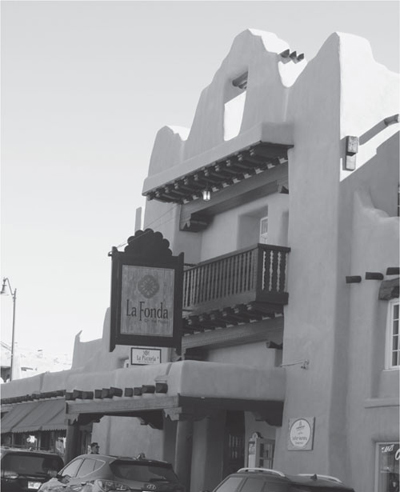
La Fonda on the Plaza is a distinctive landmark across from the St. Francis Cathedral in the heart of Santa Fe. Courtesy of the author.
Santa Fe’s loyal citizens rallied around the idea of having one of the finest hotels in the West built in the City Different, and they raised $200,000 to finance this dream.
The magnificent adobe structure we are familiar with today was built in 1922 with the design inspirations of John Gaw Meem and Mary Coulter. These conceptions include the cathedral ceilings reaching twenty-five feet, intricately carved wooden beams, hammered tin chandeliers, terra-cotta tiles and—most impressive—the stained-glass skylights. La Fonda on the Plaza takes up an entire city block in the heart of the capital city and is a stone’s throw from the famed Cathedral Basilica of St. Francis of Assisi.
A longtime landmark, La Fonda on the Plaza has taken many smaller businesses under its wing and provided Santa Fe and its hundreds of thousands of visitors a wonderful place to enjoy French pastries, unique gift shops, world-class art galleries, exclusive jewelry stores and exquisite clothing shops.
By 1925, La Fonda on the Plaza was turned into a Harvey House by founder Fred Harvey, who leased the property to serve as one of his hospitality houses along the Atchison, Topeka & Santa Fe Railway lines. To entice tourists, this Harvey House would bring in Native Americans to set up in their unique Demonstration Room within the hotel, to show how they did the fine silversmithing and exquisite rug weaving that were trademarks of the local tribes. Ahead of his time, Fred Harvey would provide tours into tribal lands and show the importance of the native art form to visitors.
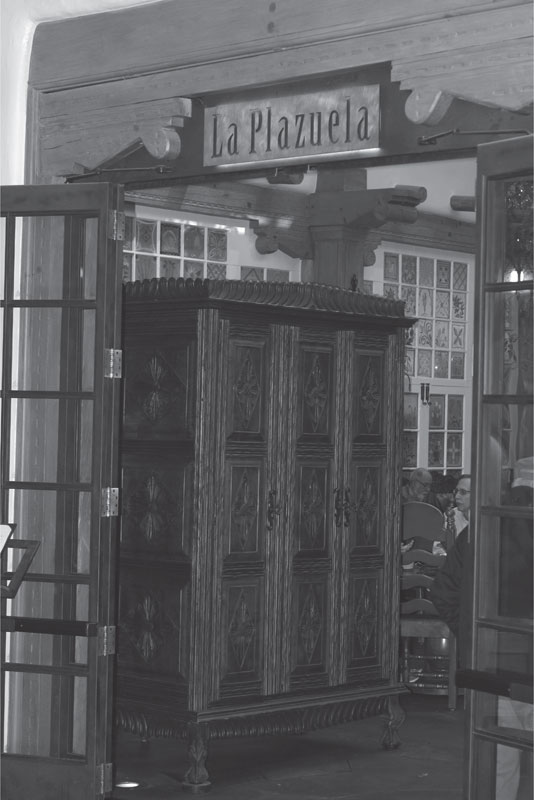
La Fonda on the Plaza’s dining room, La Plazuela, is one of the most active sites on the property for reports of apparitions. Courtesy of the author.
Among the dignitaries and celebrities who have stayed at La Fonda on the Plaza are actors Errol Flynn and Olivia de Havilland, aviator Charles Lindbergh, author Willa Cather, artist Willard Clark and U.S. presidents Rutherford Hayes, Ulysses S. Grant, John F. Kennedy and Bill Clinton. These are but a few of the names that can be dropped in connection to La Fonda on the Plaza.
The hotel would remain a Harvey House until 1968, when it was acquired by Sam and Ethel Ballen, who were lucky enough to own it until 2014 and invested millions of dollars into the project. It was then that La Fonda on the Plaza passed to the private hands of Jennifer Kimball and her brother Philip Wise (with his business firm Cienda Partners), who were longtime friends of the Ballens.
Considered a true national treasure and the epitome of Santa Fe style, La Fonda on the Plaza retains its unique character and fascinating history for the many generations to come and is proud to be a member of Historic Hotels of America, from which it received the 2016 award for Best Historic Hotel (76–200 rooms).
La Fonda on the Plaza is the perfect enchanted venue for a magical wedding, a business conference, a grand banquet or just to be pampered in the world-class spa. Be sure to check out the Bell Tower Bar atop the historic adobe, where you will be able to sip your favorite cocktail while viewing one of New Mexico’s legendary sunsets.
GHOSTS
As with any hotel sporting a four-hundred-year history, rumors of spirits abound, none of which have been debunked or proven, so use your own discretion. La Fonda on the Plaza is not the source of these stories; these tales have been passed down primarily by word of mouth.
In 1862, a Texas cowboy began to shoot up La Fonda in revenge for a friend and shot a lawyer in the stomach and another man in the arm during the fracas. The cowboy was lynched in the backyard of the hotel.
His shadow hanging from the tree is reportedly seen when the light is right on the patio.
One ghost story involves a murder. On December 15, 1867, the chief justice of the Territorial New Mexico Supreme Court, John P. Slough, was shot and killed during a violent disagreement with a member of the House of Representatives of the Territorial Legislature from Doña Ana County,
W.L. Rynerson (who was also the personal attorney of Charles B. Eddy, of Carlsbad), whom Slough had called a liar and a thief. New Mexico was an unruly territory, and many disagreements were settled at the end of a pistol. Rynerson was tried and acquitted on the ever-popular self-defense plea. It is rumored that Judge Slough’s spirit still roams the halls and lobby of the La Fonda.
Another popular rumor dates to the inception of the inn where the La Fonda now resides. It states that the first inn was also a place where court was held, and the prisoners who were found guilty were hanged in the lobby. Spirits of these poor souls are said to still be present on the site.
A deep well was in the center of the La Fonda’s dining room, now known as La Plazuela. Legend has it that a traveling salesman leapt to his death in the well after losing all his company’s money in a card game. An apparition of a man who appears to walk to the center of the dining room, jump and then disappear has been reported by the staff over the years. Nothing was written about this incident in the local newspapers at the time; the first written report was in 1991.
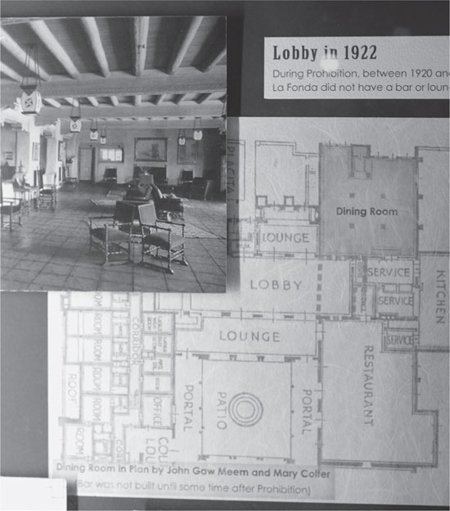
A drawing of the La Fonda lobby hangs in a side hall of the hotel and gives visitors an insight to the original structural form. Courtesy of the author.
Room 510—the Honeymoon Suite—is supposedly haunted by a young bride who was murdered by her former lover. Another story also exists about this couple. It states that the newly married couple checked into the hotel in the 1930s, and the husband began drinking heavily at the bar, got into an argument with the bartender and was shot dead at the bottom of the steps going to their room. The bride found her dead husband and pulled out a Derringer and shot herself. No reports were published in local newspapers of this incident.